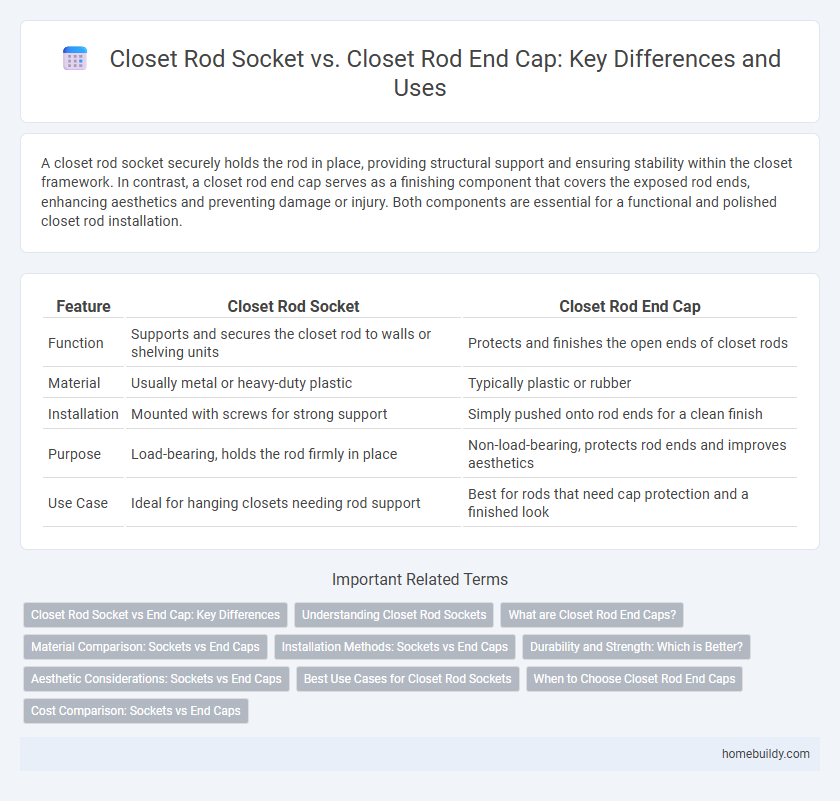A closet rod socket securely holds the rod in place, providing structural support and ensuring stability within the closet framework. In contrast, a closet rod end cap serves as a finishing component that covers the exposed rod ends, enhancing aesthetics and preventing damage or injury. Both components are essential for a functional and polished closet rod installation.
Table of Comparison
| Feature | Closet Rod Socket | Closet Rod End Cap |
|---|---|---|
| Function | Supports and secures the closet rod to walls or shelving units | Protects and finishes the open ends of closet rods |
| Material | Usually metal or heavy-duty plastic | Typically plastic or rubber |
| Installation | Mounted with screws for strong support | Simply pushed onto rod ends for a clean finish |
| Purpose | Load-bearing, holds the rod firmly in place | Non-load-bearing, protects rod ends and improves aesthetics |
| Use Case | Ideal for hanging closets needing rod support | Best for rods that need cap protection and a finished look |
Closet Rod Socket vs End Cap: Key Differences
Closet rod sockets securely hold the rod in place by fitting into the closet wall or frame, providing sturdy support and load-bearing capacity essential for hanging clothes. Closet rod end caps primarily serve as protective covers for the rod's exposed ends, preventing damage and adding a finished look without offering significant support. The key difference lies in the socket's functional role in structural support versus the end cap's purpose in protection and aesthetics.
Understanding Closet Rod Sockets
Closet rod sockets provide a secure and stable mounting point for closet rods, ensuring proper support for hanging clothes, unlike closet rod end caps which mainly serve to cover the rod's ends for a finished look. These sockets are designed to be installed into closet walls or shelving, offering durability and preventing the rod from sagging or falling. Selecting high-quality closet rod sockets is essential for maintaining closet organization and preventing damage to both the rod and stored apparel.
What are Closet Rod End Caps?
Closet rod end caps are small fixtures designed to fit over the ends of closet rods, providing a finished look and protecting the rod's edges from damage. Unlike closet rod sockets, which support and hold the rod in place within the closet structure, end caps primarily serve aesthetic and safety purposes. These caps prevent clothing from snagging on rough rod edges and contribute to a polished appearance in closet organization.
Material Comparison: Sockets vs End Caps
Closet rod sockets are typically made from durable metals such as steel or brass, providing robust support and long-term stability for closet rods, whereas closet rod end caps are often crafted from plastic or lightweight metal, designed mainly for aesthetic finishing and rod protection. The metal construction of sockets allows them to withstand significant weight and pressure, making them essential for structural integrity. End caps prioritize smooth edges and visual appeal but lack the load-bearing strength inherent in metal sockets.
Installation Methods: Sockets vs End Caps
Closet rod sockets require secure mounting to walls or brackets using screws, offering stable support for the rod's weight. Closet rod end caps simply snap or slide onto the rod's ends, providing a quick, tool-free installation but less structural support. The choice between sockets and end caps depends on the desired durability and ease of installation in closet setups.
Durability and Strength: Which is Better?
Closet rod sockets provide superior durability and strength compared to closet rod end caps due to their robust metal construction, which firmly supports heavier loads without bending or breaking. Unlike end caps, which primarily serve a finishing purpose and lack significant load-bearing capacity, rod sockets anchor the rod securely to walls or closet panels. For long-term use in heavy-duty storage, closet rod sockets are the better choice, ensuring greater stability and longevity.
Aesthetic Considerations: Sockets vs End Caps
Closet rod sockets provide a seamless and sturdy attachment point for rods, creating a clean and polished appearance that blends well with various interior styles. In contrast, closet rod end caps offer a minimalist and sleek finish by simply capping the rod ends, which enhances visual continuity without the bulk of traditional sockets. Choosing between sockets and end caps depends largely on the desired aesthetic, with sockets favoring a robust, integrated look and end caps emphasizing simplicity and subtlety.
Best Use Cases for Closet Rod Sockets
Closet rod sockets are designed to securely support heavy closet rods, making them ideal for applications requiring maximum stability and load-bearing capacity, such as in walk-in closets or commercial storage areas. Unlike closet rod end caps, which primarily serve to cover rod ends for aesthetic purposes and minor protection, rod sockets provide a structural anchor point, ensuring the rod remains firmly in place during prolonged use. Their robust design makes them the best choice for installations demanding durability and reliable weight support.
When to Choose Closet Rod End Caps
Closet rod end caps are ideal when you want to cover the exposed ends of a closet rod for a clean, finished look and to prevent clothing from slipping off. They are best chosen when no additional support or mounting is needed, unlike closet rod sockets which secure the rod in place inside the closet walls. For aesthetic purposes and minimal installation, closet rod end caps provide a simple and effective solution.
Cost Comparison: Sockets vs End Caps
Closet rod sockets generally cost more than closet rod end caps due to their additional hardware and mounting requirements. End caps, being simple finishing pieces, are typically less expensive and easier to install, reducing overall labor costs. For budget-conscious projects, choosing end caps can offer a cost-effective solution without sacrificing the rod's stability.
Closet rod socket vs Closet rod end cap Infographic

 homebuildy.com
homebuildy.com